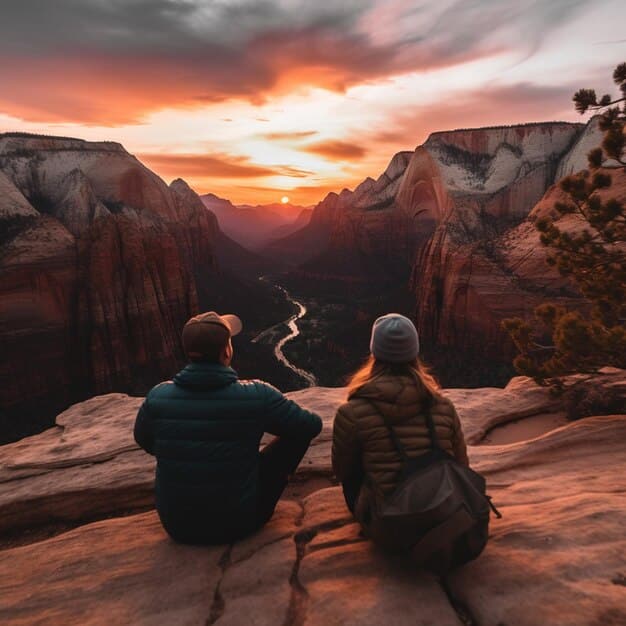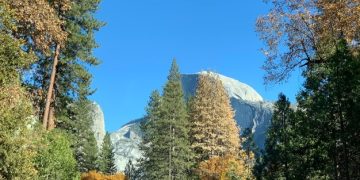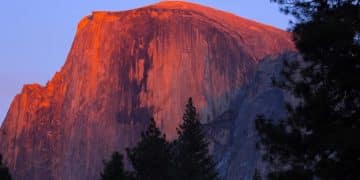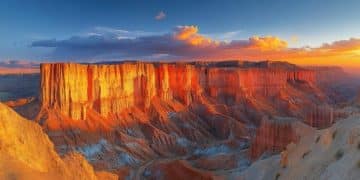US National Park Entry Updates 2025: Your Essential Travel Guide

The year 2025 ushers in significant new regulations for entry into US National Parks, encompassing reservation systems, fee adjustments, and accessibility changes, crucial for travelers planning future visits.
As the allure of America’s breathtaking landscapes continues to draw millions, staying informed about evolving access requirements is paramount for any aspiring park visitor. This Travel Guide Update: New Regulations for US National Park Entry in 2025 aims to demystify the upcoming changes, providing essential insights to ensure your next adventure is as seamless as the vistas you seek.
Understanding the Shift: Why New Regulations in 2025?
The US National Park Service (NPS) consistently balances the preservation of natural and cultural resources with providing access for public enjoyment. The new regulations for 2025 are a direct response to several evolving challenges, primarily stemming from ever-increasing visitation numbers. These changes are not arbitrary; they reflect a strategic effort to enhance the visitor experience while mitigating environmental impacts and ensuring the long-term sustainability of these iconic landscapes.
For years, popular parks have faced unprecedented crowds, leading to congestion, parking nightmares, and pressure on delicate ecosystems. These new rules are designed to spread out visitation, reduce wait times at entrance gates, and foster a more serene and enjoyable experience for everyone. They represent a significant paradigm shift from the more open access models of the past.
Addressing Over-tourism and Resource Protection
The primary driver behind these updated entry protocols is the need to combat the effects of over-tourism. Many national parks, particularly those with iconic features like Zion, Arches, and Glacier, have seen visitation surge beyond their infrastructure’s capacity. This influx often translates to:
- Increased traffic congestion on park roads and at trailheads.
- Erosion of sensitive trails and habitats due to heavy foot traffic.
- Degradation of air and water quality from vehicle emissions and human waste.
- A diminished visitor experience, characterized by crowds and long queues rather than solitude.
By implementing more structured entry requirements, the NPS aims to alleviate these pressures, allowing fragile ecosystems to recover and ensuring a higher quality experience for those who do enter.
Furthermore, these regulations aren’t just about managing people; they’re about managing the impact of people. The delicate balance of flora and fauna, the integrity of historical sites, and the sheer wilderness character of these places are at stake. Without proactive measures, the very essence of what makes these parks special could be irrevocably altered. It’s a proactive step towards ensuring future generations can experience these wonders in their pristine state.
Enhancing the Visitor Experience
While some might view new regulations as restrictive, the long-term goal is to enhance the overall visitor experience. Imagine arriving at a park and finding a parking spot easily, enjoying a trail without a constant stream of people, and truly immersing yourself in nature’s tranquility.
These new systems, particularly reservation requirements, are intended to provide a more predictable and less stressful visit. No more driving for hours only to be turned away at the gate because the park is at capacity. Instead, visitors can plan ahead, secure their entry, and arrive with the confidence that they will gain access and have a quality experience. It’s about shifting from a “first-come, first-served” chaos to a more organized and enjoyable approach to park exploration.
The transition may present a learning curve for frequent park-goers, but the benefits in terms of reduced stress and improved park immersion are expected to be substantial. It’s a trade-off: a bit more planning upfront for a significantly better experience on the ground, allowing for deeper appreciation of the natural environment.
Key Changes to Expect: Reservation Systems and Timed Entry

Perhaps the most significant change for 2025 is the widespread adoption of refined reservation systems and timed entry requirements at many of the most popular US National Parks. While some parks have experimented with these systems in the past, expect a more standardized and pervasive implementation across various high-demand locations.
These systems are designed to manage visitor flow by requiring visitors to reserve a specific entry time slot or date in advance. This move aims to prevent over-crowding at peak times and congested areas within the parks.
How Reservation Systems Will Work
The exact mechanics of reservation systems will vary slightly from park to park, but generally, travelers can anticipate:
- Online Booking Portals: Most reservations will need to be made through official park websites or Recreation.gov, often several months in advance. Early booking will be critical for securing desired dates.
- Timed Entry Windows: Visitors will typically select a specific window of time (e.g., 8:00 AM – 10:00 AM) to enter the park. Once inside, they can usually stay for the remainder of the day, though some parks may implement specific vehicle or activity durations.
- Vehicle vs. Per-Person Reservations: Some parks might require a single reservation per vehicle, while others might mandate reservations per person, particularly for specific trails or shuttle systems.
- Limited Walk-Up Availability: While some parks might retain a very limited number of first-come, first-served slots, relying on these will be a high-risk strategy, especially during peak seasons.
Understanding these nuances for each park on your itinerary will be fundamental. Failing to secure the necessary reservation could mean being turned away at the park entrance, making flexibility and early planning paramount.
Parks Likely to Implement or Expand Reservations in 2025
While the full list of parks with new or expanded reservation systems for 2025 will be officially announced by the NPS closer to the year, based on past trends and current visitation pressures, travelers should anticipate these requirements at:
- Zion National Park (Utah): Likely to continue and potentially expand its existing permit system for popular hikes like Angels Landing, and possibly extend timed entry for general park access during peak times.
- Arches National Park (Utah): Has historically used timed entry and will likely continue this model, especially for its scenic drive.
- Glacier National Park (Montana): Known for its “Going-to-the-Sun Road” vehicle reservations, which are likely to remain in place and perhaps be complemented by other sectional access requirements.
- Rocky Mountain National Park (Colorado): Their timed entry system into various park areas is expected to continue and may be adjusted based on demand.
- Yosemite National Park (California): Has experimented with various reservation systems during peak times; expect potential reintroduction or refinement of these for popular entry points.
- Acadia National Park (Maine): Cadillac Mountain’s vehicle reservation system will very likely remain, with potential for other high-traffic areas to follow suit.
This list is illustrative, not exhaustive. Travelers should always check the official NPS website for each specific park they plan to visit well in advance of their trip. The dynamic nature of these regulations means information can be updated frequently.
Fee Adjustments and Passes: What’s New for Your Budget
Beyond entry regulations, visitors to US National Parks in 2025 should also prepare for potential adjustments in entrance fees and changes to annual pass programs. The National Park Service periodically reviews and updates its fee structure to reflect operational costs, fund crucial maintenance projects, and support conservation efforts across the system.
These adjustments, while sometimes unwelcome for budget-conscious travelers, are vital for the continued upkeep and improvement of park infrastructure, from trails and campgrounds to visitor centers and educational programs. Understanding the new fee landscape is essential for accurate trip budgeting.
Potential For Fee Increases and Structure Changes
While specific figures are yet to be finalized, it’s reasonable to anticipate modest fee increases at some of the most popular national parks. These increases might apply to:
- Per-vehicle entrance fees: The standard charge for a private non-commercial vehicle.
- Per-person entrance fees: For those entering on foot, bicycle, or motorcycle.
- Camping fees: Especially for highly sought-after campsites within parks.
- Specific activity fees: For guided tours, wilderness permits, or specialized access.
Additionally, some parks might introduce tiered pricing based on demand, with higher fees during peak season or on weekends, encouraging visits during off-peak times. This dynamic pricing strategy is already in use in some areas and may become more common.
The revenue generated from these fees is reinvested directly into the parks where they are collected, supporting vital services and projects that enhance the visitor experience and protect park resources. This makes “paying to play” a direct contribution to conservation.
America the Beautiful Pass Considerations
The “America the Beautiful – The National Parks and Federal Recreational Lands Pass” remains an excellent value for frequent park visitors. This interagency annual pass covers entrance fees at national parks and national wildlife refuges, as well as standard amenity fees at national forests and grasslands, and at lands administered by the Bureau of Land Management, Bureau of Reclamation, and U.S. Army Corps of Engineers.
For 2025, while the core benefits of this pass are expected to remain intact, be aware of potential price adjustments for the pass itself. More importantly, remember that the pass covers standard entrance fees but does not cover special use fees, permit fees (like those for Angels Landing), or reservation fees for timed entry. You may still need to pay a small processing fee for online reservations, even with a pass.
For seniors, active military members, and those with permanent disabilities, various discounted or free passes are available, offering significant savings. Ensure you understand the specific eligibility criteria for these passes, as they are a fantastic way to access the parks affordably.
Accessibility and Inclusion Updates: Ensuring Parks for Everyone
A core tenet of the National Park Service is to ensure that these natural and cultural treasures are accessible to all Americans. For 2025, there’s a continued emphasis on enhancing accessibility and promoting inclusion within the parks, addressing various aspects of the visitor experience for individuals with diverse needs.
These updates go beyond mere compliance with the Americans with Disabilities Act (ADA); they reflect a thoughtful approach to making park experiences truly welcoming and navigable for everyone, regardless of physical ability, sensory processing differences, or other considerations.
Physical Accessibility Renovations and Improvements
Expect ongoing and new initiatives aimed at improving physical accessibility, which may include:
- Trail Upgrades: Development of more accessible trails with smoother surfaces, wider paths, and gentler grades, allowing more visitors to explore natural areas.
- Ramp and Elevator Installations: Improvements to visitor centers, restrooms, and interpretive facilities to include ramps, elevators, and accessible doorways.
- Accessible Restrooms and Parking: Construction of new or renovation of existing facilities to ensure they meet modern accessibility standards, including designated parking spaces closer to facilities.
- Accessible Campgrounds and Lodging: Expansion of accessible campsites with features like paved surfaces, accessible picnic tables, and nearby accessible restrooms. Some park lodges are also upgrading rooms to be more inclusive.
These efforts are crucial for enabling individuals with mobility challenges, parents with strollers, and seniors to fully enjoy the park offerings. They highlight a commitment to ensuring physical access complements the natural beauty of the parks.
Enhanced Programs and Resources for Diverse Audiences
Beyond physical infrastructure, the NPS is also focusing on programmatic and informational improvements:
- Interpretive Programs: Offering a wider range of interpretive programs, including those with sign language interpretation, audio descriptions, and accessible presentation formats.
- Sensory-Friendly Options: Developing sensory-friendly trails or quieter spaces in visitor centers for individuals with sensory processing sensitivities.
- Information Accessibility: Ensuring park websites and brochures provide clear, easily digestible information about accessibility features for each specific trail, facility, or program. This includes detailed maps highlighting accessible routes.
- Inclusion Initiatives: Efforts to promote diversity among park staff and ensure that park narratives and exhibits reflect a broad range of human experiences and cultural perspectives associated with park lands.
These comprehensive efforts aim to create a more inclusive environment where all visitors feel welcome, informed, and capable of experiencing the wonder of our national parks. It’s a testament to the idea that parks are for everyone, and that their benefits should extend to the broadest possible audience.
Permit Systems and Backcountry Access: Planning Your Wilderness Trip
For those seeking solitude and adventure beyond the paved roads, the backcountry of US National Parks offers unparalleled experiences. However, managing human impact in these remote and fragile environments is crucial. For 2025, travelers planning wilderness excursions should be aware of potential revisions and stricter enforcement of permit systems for backcountry access.
These systems are critical tools for resource protection, search and rescue management, and ensuring a high-quality wilderness experience. They help limit the number of users in sensitive areas and prevent degradation of pristine ecosystems.
Understanding Backcountry Permit Requirements
Most national parks with significant backcountry areas already require permits for overnight stays. For 2025, expect:
- Increased Competition: As frontcountry access becomes more managed, pressure on backcountry areas may increase, making permit acquisition even more competitive.
- Online Lottery Systems: Many popular zones, like those in Yosemite, Grand Canyon, and Sequoia-Kings Canyon, utilize highly competitive lottery systems for permits distributed months in advance. Understanding lottery dates and application windows is vital.
- Quotas and Designated Campsites: Expect continued use of strict quotas for specific zones or trails, often tied to designated campsites to concentrate impact and allow for faster recovery of natural areas.
- Bear Canister Requirements: Many parks in bear country enforce mandatory bear canister use for food storage. Ensure you are aware of and comply with these rules.
Securing a backcountry permit is often more challenging than obtaining a day-use entry reservation and requires meticulous planning. Familiarize yourself with the specific park’s regulations and application processes well in advance of your desired trip dates.
Rules for Day-Use Permits on Popular Trails
Beyond overnight backcountry trips, some exceptionally popular day hikes and climbing routes within national parks also require permits. For 2025, this trend is likely to continue and potentially expand to new areas. Examples include:
- Angels Landing (Zion National Park): Continues to use a permit lottery system for this iconic, strenuous hike.
- Half Dome (Yosemite National Park): Requires a daily lottery for access to the cables, a system expected to be maintained.
- The Subway (Zion National Park): Another highly sought-after canyoneering route requiring a permit.
These day-use permit systems are designed to reduce congestion on narrow, dangerous, or environmentally sensitive trails, ensuring safety and preserving the experience. Always check the park’s official website for the most current information regarding specific trail permits. Ignoring these requirements can sometimes lead to fines or being turned away mid-hike. Preparedness and adherence to these rules are crucial for an enjoyable and legal wilderness outing.
Technology and Tools: Navigating Parks in the Digital Age
As US National Parks adapt to increasing visitation and complex regulations, technology will play an even more central role in the visitor experience for 2025. From reservation systems to on-the-ground navigation, digital tools are becoming indispensable for planning and executing a seamless park visit.
Embracing these technologies can significantly enhance your trip, providing real-time information, simplifying entry, and even helping you discover hidden gems. However, it’s also crucial to understand their limitations, especially in areas with limited connectivity.
Essential Apps and Online Resources
Before you even pack your bags, familiarize yourself with these key digital assets:
- Recreation.gov: This will be your primary portal for most timed entry reservations, camping permits, and backcountry lottery applications across a wide range of national parks and federal lands. Create an account in advance.
- Official NPS App: The National Park Service offers a free app (available on iOS and Android) that compiles information for all 400+ national park sites. It includes interactive maps, self-guided tours, accessibility information, and live updates. Crucially, you can often download content for offline use before entering areas without service.
- Individual Park Websites: Each national park has its own dedicated website (e.g., nps.gov/yose). These are the definitive sources for park-specific regulations, operating hours, road closures, and unique alerts. Always check them before and during your trip.
- Google Maps/Other Navigation Apps: While useful for general navigation, be aware that cell service can be spotty or nonexistent in many park areas. Download offline maps of the park and surrounding regions before you leave home.
Relying solely on real-time internet connectivity while inside many parks is a recipe for frustration. Proactive downloading of maps and critical information is a smart strategy.
Leveraging Digital Tools for a Smoother Visit
Beyond basic information, technology can enhance your park experience in various ways:
- Digital Passes: Many park passes and reservations are now accepted digitally on your phone, reducing the need for paper printouts. Always have a backup, such as a screenshot or a printout, just in case.
- Real-Time Updates: Some park apps or websites provide real-time updates on parking availability, shuttle locations, or trail conditions, helping you adjust your plans on the fly.
- Interactive Maps: Utilize maps with GPS capabilities to track your location, identify points of interest, and plan your routes, even offline.
- Audio Guides: Many apps offer audio tours that provide context and information as you drive or hike through specific areas, enriching your understanding of the park’s history and ecology.
While technology is a great aid, always remember the core purpose of a park visit: to disconnect and immerse yourself in nature. Use these tools wisely, but don’t let them overshadow the raw beauty and tranquility of the parks themselves. A healthy balance ensures both convenience and pure enjoyment.
Preparing for Your 2025 Park Visit: Essential Tips for Travelers
With the new regulations for US National Park entry in 2025, successful trip planning requires more foresight and attention to detail than ever before. Spontaneity will less likely be rewarded, while meticulous preparation will ensure a smooth and enjoyable experience. This final section provides actionable tips to navigate the updated landscape and make the most of your park adventure.
Pre-Trip Planning Checklist for 2025
Your preparation should begin well in advance of your travel dates, especially for popular parks during peak seasons:
- Research Specific Park Regulations: The most crucial step. Visit the official NPS website for each park you intend to visit. Look for specific information on timed entry, reservation requirements, permit lotteries (for camping or popular hikes), and any unique vehicle restrictions.
- Book Reservations Early: As soon as reservation windows open (often several months out, even a year for some campsites), secure your entry times or permits. These slots fill up incredibly fast. Set reminders if necessary.
- Consider Off-Peak Travel: If your schedule allows, traveling during shoulder seasons (spring or fall) or weekdays can significantly reduce crowds and simplify the reservation process, potentially avoiding them altogether in some parks.
- Check Fee Structures: Verify the current entrance fees, amenity fees, and any special permit costs. Purchase an America the Beautiful Pass if you plan multiple park visits within a year.
- Download Offline Resources: Download park maps, the NPS app content, and any specific reservation confirmations to your device before you lose cell service. Print physical copies as a backup.
- Pack Essentials: Always bring enough water, snacks, appropriate layers of clothing, sun protection, and a first-aid kit. Research trail conditions and weather forecasts.
A well-researched itinerary, flexible mindset, and proactive approach will be your best allies in navigating these new entry requirements.
Day-Of Visit Considerations and Best Practices
Even with thorough planning, the day of your visit requires attention:
- Arrive on Time (or Early): Adhere strictly to your timed entry window. Arriving too early may mean waiting, and arriving too late could mean being turned away. Give yourself ample time to reach the gate.
- Have Documentation Ready: Keep your digital or printed reservation confirmation, park pass/entry fee receipt, and photo ID easily accessible for rangers at the entrance station.
- Check for Real-Time Updates: Even on the day of your visit, quickly check the park’s website or app for any last-minute alerts regarding road closures, trail conditions, or unforeseen events.
- Leave No Trace Principles: Always practice Leave No Trace principles: pack out everything you pack in, stay on marked trails, respect wildlife, and minimize your impact on the environment.
- Be Patient and Flexible: Despite best efforts, unexpected issues can arise. Maintain a positive attitude, be patient with park staff and fellow visitors, and be prepared to adapt your plans if necessary.
By following these guidelines, you can ensure that the new regulations for US National Park entry in 2025 serve their purpose: protecting these invaluable natural treasures while allowing you to experience their grandeur with minimal hassle and maximum enjoyment. Your adventure awaits, more organized and manageable than ever before.
| Key Point | Brief Description |
|---|---|
| 🗓️ Reservation Systems | Expect widespread timed entry and online booking at popular parks to manage crowds. Book months in advance via Recreation.gov. |
| 💰 Fee Adjustments | Potential fee increases for entrance and camping; America the Beautiful Pass is valuable but doesn’t cover all special fees. |
| ♿ Accessibility Focus | Ongoing improvements in physical accessibility and interpretive programs for diverse visitors. |
| 📱 Digital Tools | Utilize NPS app, Recreation.gov, and offline maps for planning and real-time updates. |
Frequently Asked Questions about 2025 US National Park Entry
▼
The new regulations are primarily a response to escalating visitor numbers, which have led to severe overcrowding, environmental degradation, and diminished visitor experiences in many popular parks. The National Park Service aims to manage visitor flow more effectively, protect delicate ecosystems, and ensure a higher quality, more enjoyable experience for future generations.
▼
While the full list will be officially announced, historically popular parks like Zion, Arches, Glacier, Rocky Mountain, and Yosemite are strong candidates for continued or expanded reservation systems. It’s crucial to check the official NPS website for each specific park well in advance of your visit, as requirements can vary and are subject to change based on demand and conditions.
▼
Yes, the America the Beautiful Pass will remain valid for standard entrance fees at national parks in 2025. However, it’s important to remember that the pass typically does not cover additional costs such as special permit fees (e.g., for Angels Landing), camping fees, or the small processing fees associated with timed entry reservations. Always verify specific park rules.
▼
For the most popular parks and during peak seasons (summer, holidays), reservations for timed entry and camping slots should be booked as soon as they become available. This can be several months in advance, sometimes even up to a year for highly sought-after campsites. Setting alerts and checking Recreation.gov frequently is highly recommended.
▼
If initial attempts to secure a reservation fail, consider being flexible with your dates or visiting during less popular times like weekdays or shoulder seasons (spring/fall). Explore nearby national monuments or lesser-known national parks, which often offer similar natural beauty without the strict entry requirements. Also, check for last-minute cancellations or daily lottery options if available for your chosen park.
Conclusion: Adapting to the Future of Park Access
The updated regulations for US National Park entry in 2025 represent a necessary evolution in how these cherished natural spaces are managed and experienced. While these changes may require an adjustment in how we plan our trips, they are fundamentally designed to protect the very essence of what makes these parks so special: their pristine beauty, ecological integrity, and capacity to deliver profound transformative experiences. By embracing proactive planning, utilizing available digital tools, and understanding the rationale behind these new rules, visitors can continue to enjoy the majestic wonders of America’s national parks for years to come. Your next adventure awaits, now more thoughtfully managed than ever before.





